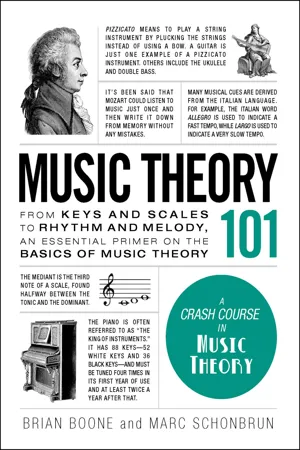![]()
Chapter 1
The Basics of Music
Whether you are new to the study of music or are adept at reading and playing music, you need to have a firm grasp of the basics and an appreciation of its rich compositional history to understand music theory. With that in mind, this chapter offers an overview of the basic musical terms and concepts upon which music theory is built, as well as a brief history of musical styles.
![]()
While there are more genres of music than we’ve got space to write them down, not to mention the subgenres of all of those, there are essentially a few overarching styles under which most music can be categorized. While all more or less follow the rules and structures of Western music theory, the following types of music also boast their own highly recognizable and innovative tropes, details, and traditions. Here’s a brief history of symphonic and orchestral musical styles.
BAROQUE (C. 1600–1760)
Baroque music is complex, soaring, heavily ornamented, and undeniably grand, and is the basis for the classical and symphonic music that followed. The baroque period produced some of the most groundbreaking composers, including Johann Sebastian Bach, Antonio Vivaldi, and George Handel.
CLASSICAL (C. 1760–1820)
While you often hear the term classical in reference to any kind of music that involves a large group of varied instruments playing a complex, lyrics-free composition, the term is more accurately applied to a certain period in European music. And while “classical” music seems fancy and grand, classical composers actually tried to strip down music to its basic and most beautiful elements in favor of clear, strong melodies. Some of the best-known composers come from the classical period, such as Wolfgang Amadeus Mozart, Ludwig van Beethoven, and Franz Joseph Haydn.
ROMANTIC (C. 1780–1900)
In the romantic era, composers attempted to evoke particular feelings and even tell stories with emotional and slightly informal pieces. They idealized nature, love, spirituality, and foreign lands in a style similar to other storytelling forms, such as opera and ballet. Major romantic composers include Johannes Brahms, Pyotr Ilyich Tchaikovsky (a.k.a. Peter Ilich Tchaikovsky), and Richard Wagner.
MODERN (C. 1900–1975)
With musical traditions going back hundreds of years, one option for modern composers was to reject history, and its rules, and instead experiment. Consistent and pleasant melody, harmony, and rhythm was often downplayed in favor of dissonance, heavy use of minor keys, strange meter, and even random sounds. Some of the notable composers who shook things up during this period include Richard Strauss, Claude Debussy, Igor Stravinsky, and Erik Satie.
Notable
Western music grew from European musical traditions. Those traditions started with the simple monophonic (or one-voice) chants used as a form of worship by monks. This was the most common type of music from about 350–1050, which means it took a good 700 years for polyphonic liturgical music (multiple voices singing different lines at the same time) to develop. Polyphonic music dominated from about 1050–1300, until more complex compositions and instrumentations began to emerge.
CONTEMPORARY SYMPHONIC MUSIC (C. 1975–PRESENT)
The history rejected by modernist composers has come full circle, with many musicians looking to the golden ages of the seventeenth and eighteenth centuries for inspiration and creating lush, textured, melody-driven symphonies. Other composers have continued to experiment with music, taking it to the very edge of logic and what could reasonably be called music, carrying on the avant-garde work of the early twentieth century. There’s also been a movement toward minimalism. Influenced by rock-and-roll, minimalists favor sparse instrumentation to deliver short melodies that repeat and grow in complexity. Major names in the last forty years of composition include Philip Glass, John Adams, and Thomas Adès.
Notable
All the music described in the previous section is Western, meaning that it stems from what’s historically been called the West: Europe and later, the Americas. Asia, Africa, the Americas, and indigenous peoples throughout the world each have their own rich musical histories—all of which can and have filled their own books. This book focuses almost entirely on the forms and systems of Western music.
![]()
Music theory explores what has been done in other music in order to reach a greater overall understanding. Since you will see the language of written music throughout this book, you must be able to read it. You will need to read in multiple clefs, since standard notation uses treble and bass clefs at a minimum and often throws in alto clef too. Here is a basic review to help you make sense of what you are reading. There is also a somewhat detailed review of rhythms because it can be a difficult concept to understand; even if you know how to decipher the notes on a staff, you may still be uneasy with the counting aspect. If this chapter is already scaring you, you can get a brief tutorial on reading music in Chapters 9 and 10 of this book or you might want to pick up a book strictly on reading music and keep it around; it will help you greatly in understanding this material!
NOTES
What better place to start than with notes? Here’s a short sample of music; try to dissect what’s going on and see if you have all the information you need.
As you can see from this figure, this is a short excerpt from a piece of solo piano music. Here is what you are seeing:
1. There are notes placed on two musical staffs: one treble staff and one bass staff.
2. The staffs are further defined by their clefs.
3. The notes are identified only by use of a clef; otherwise, they are simply dots sitting on lines and spaces.
If you want to talk about the notes, you have to talk about clefs because clefs actually define the name of the notes in a staff.
CLEFS
A clef is a symbol that sits at the be...

